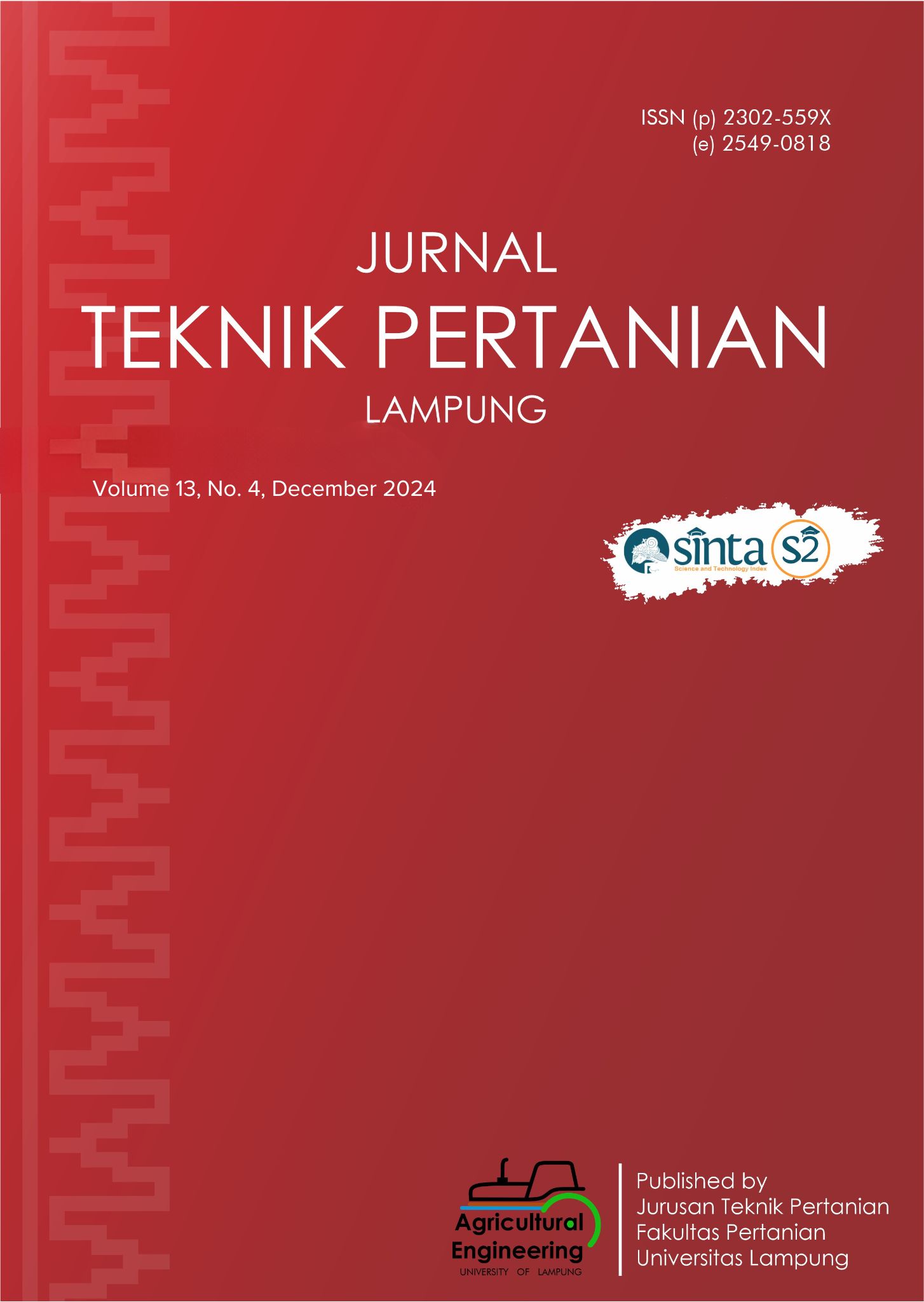Energy Analysis in the Production of Purple Sweet Potato Crackers
DOI:
https://doi.org/10.23960/jtep-l.v13i4.1344-1351Abstract
The production process of purple sweet potato (PSP) crackers involves several stages, including peeling, washing, boiling, kneading, grinding, cutting, frying, and packaging. This study aims to analyze the energy flow and production costs associated with each stage of processing sweet potatoes into crackers at the Azizah Crackers Production House in Padang City. The types of energy considered in this study included human labor, fuel gas, electricity, and raw materials (PSP, cooking oil, and supporting materials). Results showed that the total input energy for the production of PSP crackers was 784,629.95 kJ with average output energy of PSP crackers 803,880.00 kJ. The energy output of PSP crackers was 1.02 times the energy input. The cutting and frying activity required the largest input energy of 46.18% (362,310.15 kJ), while packaging activity required the smallest energy of 0.38% (2,992.33 kJ). Based on the energy type, raw materials contribute the largest energy, amounted to 85.83% (674,822.86 kJ), and the smallest type of energy was electrical energy, which was 0.74% (5,839.72 kJ).
Keywords: Energy consumption. Energy flow, Production costs, Production process, PSP Crackers.
References
Al Momani, D., Al Turk, Y., Abuashour, M.I., Khalid, H.M., Muyeen, S.M., Sweidan, T.O., Said, Z., & Hasanuzzaman, M. (2023). Energy saving potential analysis applying factory scale energy audit – A case study of food production. Heliyon, 9(3), e14216. https://doi.org/10.1016/j.heliyon.2023.e14216
Darely, P. (2020). Kusuka Keripik ubi. NilaiGizi.com. https://nilaigizi.com/gizi/detailproduk/1629/Kusuka-keripik-ubi . Diakses Pada 03 Maret 2024
Ekafitri, R., & Faradilla. F. (2011). Pemanfaatan komoditas lokal sebagai bahan baku pangan darurat. Pangan, 20(2), 153–161.
Fatsecretindonesia. 2024. Mobile.fatsecret.co.id. https://www.fatsecret.co.id/kalori-gizi/superindo/ubi-ungu/100g?frc=True. Diakses Pada 03 Maret 2024
Ginting, E., Utomo, J.S., Yulifianti, R., & Jusuf, M. (2011). Potensi ubi jalar ungu sebagai pangan fungsional. Iptek Tanaman Pangan, 6(1), 116–138.
Kartiasih, Fitri., Syaukat, Yusman & Anggraeni, Lukytawati. 2012. Determinan Intensitas Energi di Indonesia. Jurnal Ekonomi dan Pembangunan Indonesia, 12(2), 192-214.
Kosemani, B. S. & Bamgboye, A. I. 2020. Energy Input- output Analysis of Rice Production in Nigeria. Jurnal Pre-proof. https://doi.org/10.1016/j.energy.2020.118258.
Maulana, M.D, & Saputra, R.A. (2023) Simulasi prosedur pengeluaran barang jadi (minyak goreng) pada PT. Wina 3. [Internship Report]. Semen Indonesia International University.
Mutiara, D. (2020). Analisis nilai tambah home indutri stik ubi ungu di Kabupaten Oku Timur. Jurnal Bakti Agribisnis, 6(2), 7–16. https://doi.org/10.53488/jba.v6i02.90
Putri, R.E., Fadhilah, R., Cherie, D., & Novianda, A.W. (2020). Analysis of energy consumption and performance test on rice planting using rice transplanter: A case study in West Sumatera Province, Indonesia. Journal of Applied Agricultural Science and Technology, 4(1), 12-25. https://doi.org/10.32530/jaast.v4i1.152
Putri, R.E., Lubis, M.I.A., Hasan, A., & Arlius, F. (2020). Realtime measurement of human labor energy for primary tillage operation in paddy cultivation. IOP Conference Series: Earth and Environmental Science, 583, 012031. https://doi.org/10.1088/1755-1315/583/1/012031
Putri, R.E., Santosa., Cahyani, G.A., Fahmy, K., Arlius, F., & Hasan, A. (2020). Comparison of performance and total energy requirement for several harvesting method of Indonesian Farmers. IOP Conference Series: Earth and Environmental Science, 515, 012004. https://doi.org/10.1088/1755-1315/515/1/012004
Qinah, E. (2009). Pengaruh Konsentrasi Gula Pasir dan Tepung Ketan Terhadap Sifat Kimia, Organoleptik serta Daya Simpan Dodol Ubi Jalar Ungu. [Master Thesis]. Fakultas Kesehatan Masyarakat, Universitas Sumatera Utara, Medan.
Ramanda, M.R., Nurjanah, S., & Widyasanti, A. (2021). Audit energi proses pengolahan teh hitam (CTC) dengan sistem pengambilan keputusan metode space. Jurnal Teknik Pertanian Lampung, 10(2), 183–192. https://doi.org/10.23960/jtep-l.v10i2.183-192
Rehiara, A., Musa, A.Y., & Stepanus, J.B. (2023). Energy auditing and electricity saving opportunities in BPOM Laboratory of Manokwari. Social, Ecology, Economic for Sustainable Developmeny Goals Journal. 1(1), 1–17. https://doi.org/10.61511/seesdgj.v1i1.2023.22
Rijal, M., Natsir, N.A., & Sere, I. (2019). Analysis of nutrient content in purple sweet potato flour (Ipomoea Batatas Var Ayumurasaki) with sunlight and oven drying. Jurnal Biotek, 7(1), 48–57.
Setiawan, A. (2022). Studi audit energi dan ekonomi budidaya tanaman bawang merah (Allium cepa) di Nagari Salayo Tanang, Kabupaten Solok, Sumatera Barat. [Thesis]. Faculty of Agricultural Technology. Andalas University.
Sugandi, W.K., Nurjanah, S., & Aji, R.P. (2018). Analisis energi pada proses pembuatan kerupuk udang (Studi kasus di PD. Sri Tanjung, Kabupaten Indramayu, Jawa Barat). Teknotan, 12(1), 87–95. https://doi.org/10.24198/jt.vol12n1.10
Syahrun, A. (2022). Studi aliran energi produksi kopi bubuk di pabrik kopi bubuk “Cap Teko†Kota Sawahlunto. [Thesis]. Faculty of Agricultural Technology. Andalas University.
Tomášková, T., Duda, D., Abrhám, V., Yanovych, V., & Uruba, V. (2023). The concept, approach and benefits of energy auditing and its impact on the environment. MATEC Web Conference, 383(00020). https://doi.org/10.1051/matecconf/202338300020
Wardhana, A.S.J., & Damarwan, E.S. (2023). Identification of energy saving potential through energy audit at PT. ABC. Jurnal Edukasi Elektro, 7(1), 63–74. http://dx.doi.org/10.21831/jee.v7i1.61657
Downloads
Published
Issue
Section
License
- Authors who publish with this journal agree to the following terms:
- Authors retain copyright and grant the journal right of first publication with the work simultaneously licensed under a Creative Commons Attribution-ShareAlike 4.0 International Lice that allows others to share the work with an acknowledgement of the work's authorship and initial publication in this journal.
- Authors are able to enter into separate, additional contractual arrangements for the non-exclusive distribution of the journal's published version of the work (e.g., post it to an institutional repository or publish it in a book), with an acknowledgement of its initial publication in this journal.
- Authors are permitted and encouraged to post their work online (e.g., in institutional repositories or on their website) prior to and during the submission process, as it can lead to productive exchanges, as well as earlier and greater citation of published work (See The Effect of Open Access).
Jurnal Teknik Pertanian Lampung

JTEPL is licensed under a Creative Commons Attribution-ShareAlike 4.0 International License.

